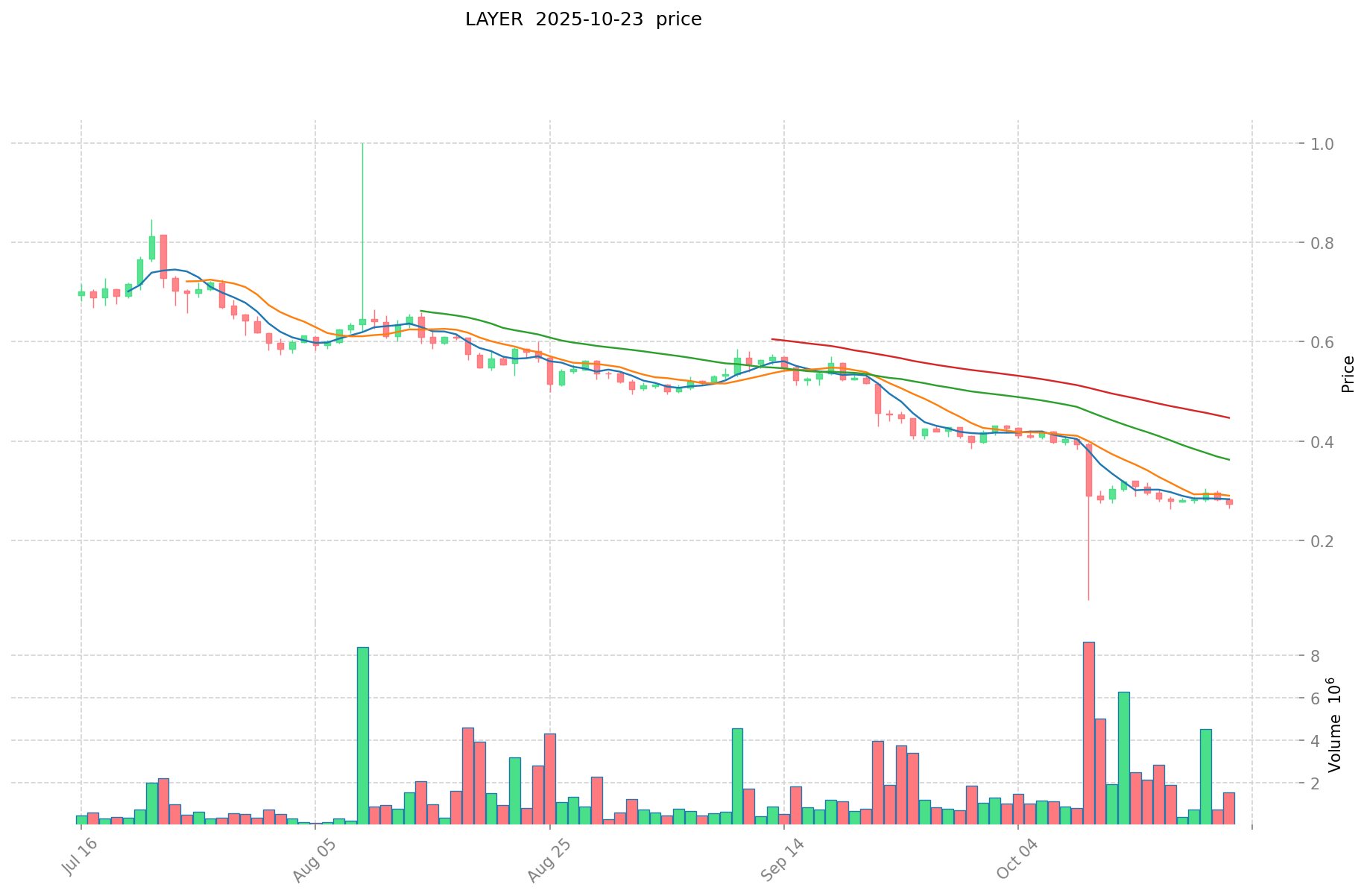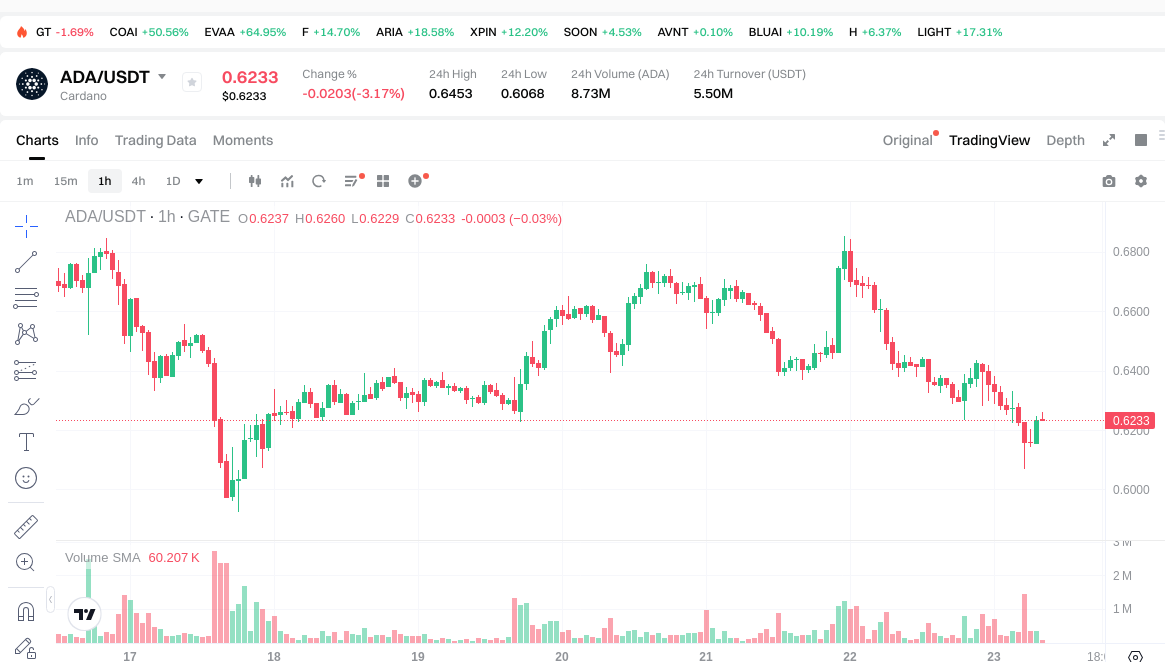LAYER vs ADA: Comparing Two Approaches to Adaptive Machine Learning
Introduction: Investment Comparison of LAYER vs ADA
In the cryptocurrency market, the comparison between Solayer (LAYER) vs Cardano (ADA) has always been a topic that investors cannot ignore. The two not only have significant differences in market cap ranking, application scenarios, and price performance, but also represent different positioning in crypto assets.
Solayer (LAYER): Since its launch, it has gained market recognition as a restaking platform on Solana, aiming to improve security and yield.
Cardano (ADA): Since its inception in 2017, it has been hailed as a technology platform capable of running financial applications used by individuals, organizations, and governments worldwide.
This article will provide a comprehensive analysis of the investment value comparison between LAYER and ADA, focusing on historical price trends, supply mechanisms, institutional adoption, technological ecosystems, and future predictions, attempting to answer the question investors care about most:
"Which is the better buy right now?"
I. Price History Comparison and Current Market Status
LAYER and ADA Historical Price Trends
- 2025: LAYER launched on Solana platform, price increased to $3.4159.
- 2021: ADA reached its all-time high of $3.09 due to smart contract implementation.
- Comparative analysis: In the recent market cycle, LAYER dropped from $3.4159 to $0.2718, while ADA declined from $3.09 to $0.6238.
Current Market Situation (2025-10-23)
- LAYER current price: $0.2718
- ADA current price: $0.6238
- 24-hour trading volume: LAYER $423,435 vs ADA $5,505,765
- Market Sentiment Index (Fear & Greed Index): 25 (Extreme Fear)
Click to view real-time prices:
- View LAYER current price Market Price
- View ADA current price Market Price


ADA Investment Value Analysis: Core Factors
I. What is ADA and its Core Value Proposition
ADA is the native cryptocurrency of the Cardano blockchain platform, which differentiates itself from other cryptocurrencies through its focus on scalability, governance, and financial inclusion. Unlike Bitcoin, which primarily focuses on value storage, and Ethereum, which emphasizes smart contracts, Cardano/ADA combines multiple functions within its ecosystem.
The core value proposition of ADA includes:
- Multi-functionality: ADA serves as both a payment mechanism and governance token
- Academic foundation: Built on peer-reviewed research and formal verification methods
- Sustainable ecosystem: Through staking rewards and treasury system for development funding
II. Core Factors Affecting ADA Investment Value
Supply Mechanism (Tokenomics)
- ADA: Fixed maximum supply of 45 billion tokens, with approximately 70% already in circulation
- Bitcoin comparison: Unlike Bitcoin's halving mechanism, ADA relies on a pre-determined supply cap
- 📌 Historical pattern: ADA price shows significant correlation with Bitcoin market cycles, with potential for independent movement based on ecosystem development
Institutional Adoption and Market Applications
- Institutional holdings: Growing institutional interest, though less than Bitcoin or Ethereum
- Enterprise adoption: Focused on financial applications, cross-border payments, and identity solutions
- Regulatory stance: Generally favorable regulatory reception in many jurisdictions due to its academic approach and compliance-friendly design
Technical Development and Ecosystem Building
- ADA technical upgrades: Layered architecture with settlement layer and computation layer for smart contracts
- Ecosystem development: Expanding DeFi applications, NFT capabilities, and real-world asset tokenization
- Comparative advantage: Academic approach to blockchain development providing security and formal verification
Macroeconomic Factors and Market Cycles
- Performance in inflationary environments: Potential hedge against inflation, though with higher volatility than Bitcoin
- Monetary policy impacts: Sensitive to interest rate changes and USD strength
- Market cycle influence: Strong correlation with broader crypto market cycles, particularly following Bitcoin's lead
III. Key Metrics and Performance Indicators
On-Chain Activity Analysis
- Daily active addresses: Approximately 30,000, showing stable user engagement
- Transaction volume: Processing about 92,000 daily transactions in Q2 2025
- New address growth: Steady increase in new users accessing the Cardano ecosystem
Whale Activity and Holder Distribution
- Large wallet behavior: Significant movements observed with whales accumulating during price dips
- Long-term holding: Over 70% of ADA tokens held by long-term investors, reducing selling pressure
- Institutional vs. retail balance: Growing institutional interest complementing strong retail community support
IV. Future Outlook and Potential Catalysts
Technical Development Roadmap
- Scaling solutions: Implementation of Hydra and other layer-2 solutions to enhance throughput
- Smart contract optimization: Continued development of Plutus for more efficient dApp creation
- Interoperability features: Cross-chain capabilities enhancing utility across the blockchain ecosystem
Market Position and Competitive Analysis
- Differentiation factors: Academic approach, formal verification, and sustainable treasury system
- Competitive challenges: Slower development pace compared to some competitors, balancing quality with time-to-market
- Unique value proposition: Focus on developing markets and financial inclusion applications
Price Projections and Market Scenarios
- Bull market potential: Technical analysis suggests possible targets of $1.14 in near term, with potential for $2-5 range in strong market conditions
- Support levels: Key support established at $0.82, with secondary support at $0.68-0.72 range
- Market correlation: Continued significant correlation with Bitcoin market cycles expected
III. 2025-2030 Price Prediction: LAYER vs ADA
Short-term Prediction (2025)
- LAYER: Conservative $0.24516 - $0.2724 | Optimistic $0.2724 - $0.28602
- ADA: Conservative $0.367865 - $0.6235 | Optimistic $0.6235 - $0.679615
Mid-term Prediction (2027)
- LAYER may enter a growth phase, with an estimated price range of $0.27334659 - $0.43612602
- ADA may enter a bullish market, with an estimated price range of $0.549653907 - $1.025030259
- Key drivers: Institutional capital inflow, ETFs, ecosystem development
Long-term Prediction (2030)
- LAYER: Base scenario $0.483637342914 - $0.64807403950476 | Optimistic scenario $0.64807403950476+
- ADA: Base scenario $1.2385247497854 - $1.746319897197414 | Optimistic scenario $1.746319897197414+
Disclaimer: The above predictions are based on historical data and market analysis. Cryptocurrency markets are highly volatile and subject to rapid changes. These projections should not be considered as financial advice. Always conduct your own research before making investment decisions.
LAYER:
| 年份 | 预测最高价 | 预测平均价格 | 预测最低价 | 涨跌幅 |
|---|---|---|---|---|
| 2025 | 0.28602 | 0.2724 | 0.24516 | 0 |
| 2026 | 0.335052 | 0.27921 | 0.2149917 | 2 |
| 2027 | 0.43612602 | 0.307131 | 0.27334659 | 12 |
| 2028 | 0.5239961991 | 0.37162851 | 0.2638562421 | 36 |
| 2029 | 0.519462331278 | 0.44781235455 | 0.250774918548 | 64 |
| 2030 | 0.64807403950476 | 0.483637342914 | 0.40625536804776 | 77 |
ADA:
| 年份 | 预测最高价 | 预测平均价格 | 预测最低价 | 涨跌幅 |
|---|---|---|---|---|
| 2025 | 0.679615 | 0.6235 | 0.367865 | 0 |
| 2026 | 0.8339936 | 0.6515575 | 0.5994329 | 4 |
| 2027 | 1.025030259 | 0.74277555 | 0.549653907 | 19 |
| 2028 | 1.11371765967 | 0.8839029045 | 0.68944426551 | 41 |
| 2029 | 1.4782392174858 | 0.998810282085 | 0.9189054595182 | 60 |
| 2030 | 1.746319897197414 | 1.2385247497854 | 1.139442769802568 | 98 |
IV. Investment Strategy Comparison: LAYER vs ADA
Long-term vs Short-term Investment Strategies
- LAYER: Suitable for investors focused on Solana ecosystem potential and restaking innovations
- ADA: Suitable for investors seeking long-term growth and academic-backed blockchain development
Risk Management and Asset Allocation
- Conservative investors: LAYER: 30% vs ADA: 70%
- Aggressive investors: LAYER: 60% vs ADA: 40%
- Hedging tools: Stablecoin allocation, options, cross-currency portfolio
V. Potential Risk Comparison
Market Risk
- LAYER: Higher volatility due to smaller market cap and newer project status
- ADA: Susceptible to broader crypto market trends and Bitcoin cycle influence
Technical Risk
- LAYER: Scalability, network stability on Solana
- ADA: Development pace, smart contract adoption rate
Regulatory Risk
- Global regulatory policies may impact both, with ADA potentially having an advantage due to its academic approach and compliance focus
VI. Conclusion: Which Is the Better Buy?
📌 Investment Value Summary:
- LAYER advantages: Innovative restaking model, growth potential within Solana ecosystem
- ADA advantages: Strong academic foundation, established ecosystem, focus on sustainability and scalability
✅ Investment Advice:
- New investors: Consider a balanced approach with a larger allocation to ADA for its established presence
- Experienced investors: Explore LAYER for higher growth potential while maintaining a significant ADA position
- Institutional investors: ADA may be more suitable due to its market cap, liquidity, and institutional-grade development approach
⚠️ Risk Warning: Cryptocurrency markets are highly volatile. This article does not constitute investment advice. None
VII. FAQ
Q1: What are the key differences between LAYER and ADA? A: LAYER is a newer project focused on restaking on the Solana ecosystem, while ADA is an established blockchain platform with a focus on scalability, governance, and financial inclusion. LAYER has a smaller market cap and higher volatility, whereas ADA has a larger ecosystem and academic backing.
Q2: Which cryptocurrency has shown better price performance recently? A: As of October 23, 2025, ADA is trading at $0.6238, while LAYER is at $0.2718. ADA has shown more stability in price, while LAYER has experienced a more significant drop from its all-time high.
Q3: What are the main factors affecting the investment value of ADA? A: The main factors include its fixed supply mechanism, growing institutional adoption, ongoing technical development, and its performance in relation to broader market cycles and macroeconomic factors.
Q4: How do the long-term price predictions for LAYER and ADA compare? A: By 2030, LAYER's base scenario price range is predicted to be $0.483637342914 - $0.64807403950476, while ADA's base scenario range is $1.2385247497854 - $1.746319897197414, suggesting potentially higher long-term growth for ADA.
Q5: What are the key risks associated with investing in LAYER and ADA? A: Both face market risks related to crypto volatility. LAYER has additional technical risks due to its reliance on the Solana ecosystem, while ADA faces risks related to development pace and smart contract adoption. Regulatory risks apply to both, though ADA may have an advantage due to its compliance-friendly approach.
Q6: How should investors allocate their portfolio between LAYER and ADA? A: Conservative investors might consider allocating 30% to LAYER and 70% to ADA, while aggressive investors might opt for 60% LAYER and 40% ADA. The specific allocation should depend on individual risk tolerance and investment goals.
Q7: Which cryptocurrency might be more suitable for institutional investors? A: ADA may be more suitable for institutional investors due to its larger market cap, higher liquidity, and institutional-grade development approach backed by academic research and formal verification methods.
Share
Content